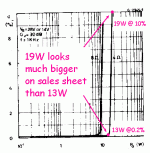You should measure your own hearing. I can definitely hear 3rd harmonic around -55dB for low frequencies (100 to 300Hz range), which is about 0.18% distortion.
Does your car sound system sound distorted to you?
Most of them run 10% or more.
Do our home speakers sound distorted?
Average speaker distortion is 3 to 5%.
Do your headphones sound distorted?
Average h/p distortion is 1 to 5%.
To Douglas Blake:
Indeed, the distortions that you've pointed out are typical of consumer equipment.
Yet, for some odd reason, they're tolerated and not "nitpicked" like the "finer" audio equipment usually is.
Indeed, the distortions that you've pointed out are typical of consumer equipment.
Yet, for some odd reason, they're tolerated and not "nitpicked" like the "finer" audio equipment usually is.
To Douglas Blake:
Indeed, the distortions that you've pointed out are typical of consumer equipment.
Yet, for some odd reason, they're tolerated and not "nitpicked" like the "finer" audio equipment usually is.
Yep, I've never quite understood that. Any amplifier based distortion, except of the most horrendous kind, is most often masked behind speaker errors, stylus chatter on turntables and distortion recorded into sources. Yet people will spend horrendous amounts of effort and money beating down a microscopic amount of distortion in an amplifier hoping for better sound.
I always tell people that if they want to improve their systems they should put the effort and money into speakers. That's where 90% of the distortion lives.
Does your car sound system sound distorted to you?
Most of them run 10% or more....
That's to get the Power Output spec way up. It is into clipping. (Altho this seems to be the normal operating mode for many drivers.)
All the current car-sound chips will be below 1% at 70% of over-rated power, and most will be <0.2% at moderate sound levels.
I would argue that your speaker numbers are also taken at high level. However speaker distortion does not fall-off as fast as NFB amplifiers and they sure do have higher THD than most amplifiers at normal working level. (However speakers mostly distort "bass" (or bottom of midrange driver) and may be cleaner over much of their range.)
Attachments
Last edited:
That's to get the Power Output spec way up. It is into clipping. (Altho this seems to be the normal operating mode for many drivers.)
All the current car-sound chips will be below 1% at 70% of over-rated power, and most will be <0.2% at moderate sound levels.
I would argue that your speaker numbers are also taken at high level. However speaker distortion does not fall-off as fast as NFB amplifiers and they sure do have higher THD than most amplifiers at normal working level. (However speakers mostly distort "bass" (or bottom of midrange driver) and may be cleaner over much of their range.)
If might not be the case now but there was a time when most automotive audio was running in Class B, with distortion that remained pretty much 10% all the way through. Class D amplification was a real boon to that segment.
Actually the speaker numbers are much harder to come by. I'm guessing they're somewhere above the 1w/1m measuring standard.
But no matter how you cut it, the distortions from sources, recordings and speakers far overshadow that from amplifiers.
If might not be the case now but there was a time when most automotive audio was running in Class B, with distortion that remained pretty much 10% all the way through. Class D amplification was a real boon to that segment.
Actually the speaker numbers are much harder to come by. I'm guessing they're somewhere above the 1w/1m measuring standard.
But no matter how you cut it, the distortions from sources, recordings and speakers far overshadow that from amplifiers.
We can't control the recording, but we can choose a speaker with low distortion or a band with low distortion.
We can't control the recording, but we can choose a speaker with low distortion or a band with low distortion.
Exactly. The distortion from most preamps and amplifiers has been so low as to be inaudilble for a very long time.
Exactly. The distortion from most preamps and amplifiers has been so low as to be inaudilble for a very long time.
😉
- Home
- Amplifiers
- Solid State
- McIntosh power amplifiers
